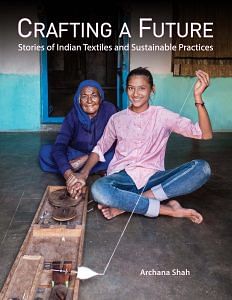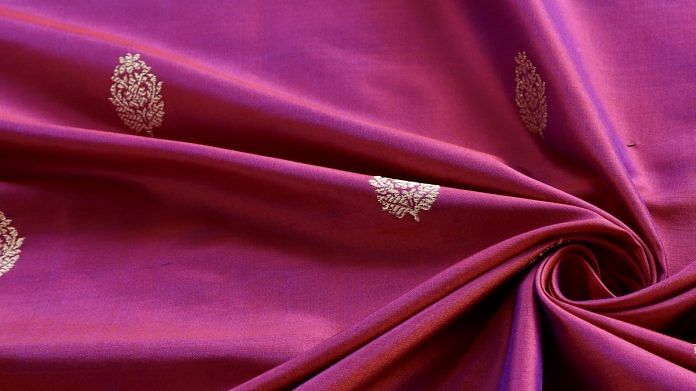References in old Pali texts suggest that Benares was earlier a centre for cotton weaving. With the migration of silk weavers from Gujarat during the famine of 1603, it is likely that silk brocade weaving and the widespread use of silk may have started there in the early 17th century. Under the patronage of the Mughal court, these luxurious brocades reached a high level of excellence and came to be known as kinkhwab, the fabric of dreams. The Tibetan monks were so captivated by the Mughal kinkhwab brocades that in the mid-1800s they commissioned the weavers of Benares to develop the gos-chen, ceremonial tapestries, earlier sourced from China. These ceremonial brocades are called gyasars in India.
For many generations, Haji Tafseer Ahmed Ansari’s family has been weaving intricate gyasar and other brocade fabrics for the Tibetan market. He lives and works in the Pili Kothi area, where many families wove the special gyasars for the monasteries, and ceremonial clothing for the Dalai Lama and high priests in Tibet. In the 1950s, when China took over Tibet, the export of brocades from India was adversely affected. Most of the weavers in this area switched to weaving sarees for the local market. Only Haji Shamshuddin Ansari (Tafseerbhai’s father), operating through their family firm, Kasim Arts, continued the tradition and today their business has expanded exponentially. They export these brocades to Tibet via Kathmandu and Mongolia. The elaborately patterned gyasar brocades of superior quality are also used in clothing and home furnishings, and there is a growing demand for them from the fashion industry in India and overseas.
Gyasar brocades are woven on a dense silk warp 56 centimetres in width, to a maximum length of 3.5 metres to maintain the tautness of the warp. The elaborate patterns are created in kadwa kaam, where multiple wefts are interlaced to create a pattern, and two weavers need to sit next to each other to manipulate the threads manually to create the patterns. Subsequently, the patterns were created with the help of a jala, or harness, attached to the loom. A person at the back of the loom would manipulate the jala, which acted as a master harness lifting and dropping the warp threads to a predetermined pattern. A single paddle was used for the jala manipulation and another for the binding weft.
Also read: Asili by Anika introduces resin art glasses with a twist and a swirl
For almost three decades, I have been working with two families of weavers in Benares who run Kasim Arts and Nilambari Sarees and have seen dramatic changes happen in these years. The jala has been replaced by a jacquard device, and 6000 to 7000 jacquard cards are required to create a pattern. Some elaborate patterns use up to 10,000 cards. Now the conventional looms are gradually being replaced by more sophisticated power looms, while the cumbersome jacquards are being replaced by a computer chip, and the warp threads to create the design are manipulated through data on a pen drive.
The Tibetan monks send old swatches to be replicated and there has been a substantial increase in the export of the gyasar than, each of 3.5 metres, in the last five years. A multi-coloured, elaborately patterned gyasar than in real zari (silver and gold thread) costs over Rs 100,000 today, while a similar piece in imitation zari would cost from Rs 13,000 to Rs 18,000. It is often difficult to distinguish between the two fabrics, but Tafseerbhai says that there is a growing market for both these qualities. They export over 300 gyasar thans and other brocade fabrics per month.
The highly skilled weavers of Benares are capable of replicating the most complex textiles. It is said that what is not possible to weave elsewhere in the country can be woven by the artisans of Benares. For many years now, the textiles had deteriorated in quality as a result of the market demand for cheaper products. However, during my visit to Varanasi in 2018, I was very happy to observe that there were weavers who continued to produce some beautiful textiles, and the quality of workmanship had significantly improved. ‘We have the karigari (artistry), now there is a market and select customers who desire special sarees and fabrics and are willing to pay the price. So, there is no compromise on quality,’ explained Tafseerbhai. If there is a regular market where customers are willing to pay the price, there are highly skilled artisans around the country who continue to have the patience and ability to recreate the heritage textiles that we admire in museums.
The Sarees of Benares
The grand benaresi sarees have a distinctive look and continue to be the most sought-after wedding sarees, especially for north Indian brides. The sarees are woven in the kadwa technique of interlacing multiple wefts to create patterns, leaving a clean finish on the reverse side of the saree. The traditional benaresi saree has an elaborate border and pallu, with a special feature, the konia, or a cross paisley pattern, at the end of the pallu with buttas (motifs) or a jaal (creeper pattern) throughout the body. This was a very time-consuming process, so today only the very expensive sarees are woven in the kadwa style. To save on cost, the patterns are no longer interlaced (kadwa). They are created with a single weft, which forms long floats (weft threads) between the motifs on the reverse side of the fabric. These floats are carefully cut by skilled women artisans after the saree is removed from the loom.
The more expensive and elaborately patterned sarees continue to be woven on a pit loom, but the jala used to manipulate the warp threads to create the patterns has been replaced by a jacquard device attached on top of the loom. Depending on the intricacy of the pattern, anywhere between 1200 and 4000 cards are required to weave a saree. It costs between Rs 16,000 and Rs 20,000 to develop a new design and, for a more intricate pattern, the cost can go up to Rs 60,000. A weaver manages to weave three sarees a month, and a few designs that become popular continue to be produced for two to five years, and are offered in many colour variations. While the jacquard does most of the lifting of the warp threads, skill is required to manipulate the multiple weft shuttles to create the pattern with a clean finish. Depending on the skill and output of the weaver, he earns anywhere between Rs 350 and Rs 800 for a day’s work. The less expensive, mass-produced sarees are woven on power looms.
Power looms were first introduced in Benares in the mid-1990s. Slowly, more and more production is shifting from handlooms to power looms as this is cost-effective, but the power-loom sarees have lost the charm of the old benaresi sarees. What is most unfortunate is that in this process, a very large number of weavers and other associated with the production of benaresi sarees have lost their livelihood, creating much distress.
Until a decade ago, the silk weaving industry provided a livelihood for about 700,000 people in Benares. This has now been reduced to less than 250,000 people, whose main concern now is their vastly reduced incomes. There are almost 1,000,000 weavers in and around Benares and an equal number of people such as dyers, bobbin makers, and the women involved in finishing the fabric, who support the weaving industry, and most are struggling to find work. Tafseerbhai mentioned that each brocade fabric is an amalgamation of Hindu and Muslim artisanal skills. A majority of the weavers are Muslims, but the zari and yarn suppliers are Hindus. Traders and consumers of the benaresi sarees too are predominantly Hindus. For centuries, Muslims and Hindus have been interdependent in this line of work and have lived in harmony.
Now, the old way of life has been disrupted because mechanisation has resulted in a loss of jobs in the weaving industry, and the weavers are being forced to look at other work options. Kadirbhai, an entrepreneur who has over 200 looms, talked about reverse migration. ‘The city has become very congested and expensive and many weavers are thinking of moving to the village. Our work is interconnected, so all members in the supply chain would collectively need to make this move,’ he added.
Weaving continues to be a hereditary profession but with a decline in demand and wages, the educated younger generation are losing interest as they find the work monotonous, demanding focused attention and not remunerative for the effort. Kadirbhai says, ‘Once you start wearing pants instead of the traditional lungi, you become useless for the loom.’ The problem is that the young have not found alternative options for earning a living. This is the sad plight of many craftsmen, a loss of identity and livelihood. This can change if there is a sustained demand, which offers decent wages. This would encourage the young to practise their craft as the artisanal skills run in their DNA, and they have observed their parents at work.
 This excerpt from ‘Crafting a Future: Stories of Indian Textiles and Sustainable Practices’ edited by Tara Gandhi, has been published with permission from Niyogi Books.
This excerpt from ‘Crafting a Future: Stories of Indian Textiles and Sustainable Practices’ edited by Tara Gandhi, has been published with permission from Niyogi Books.



